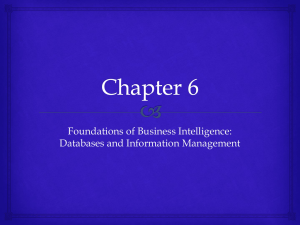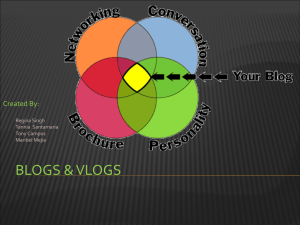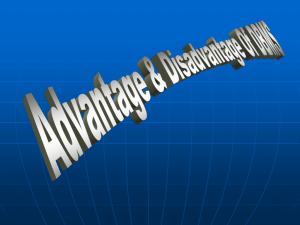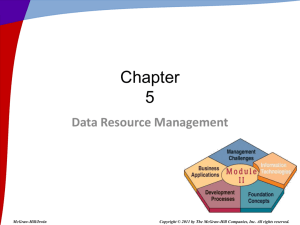IT Infrastructure & Networking Exam Questions
advertisement
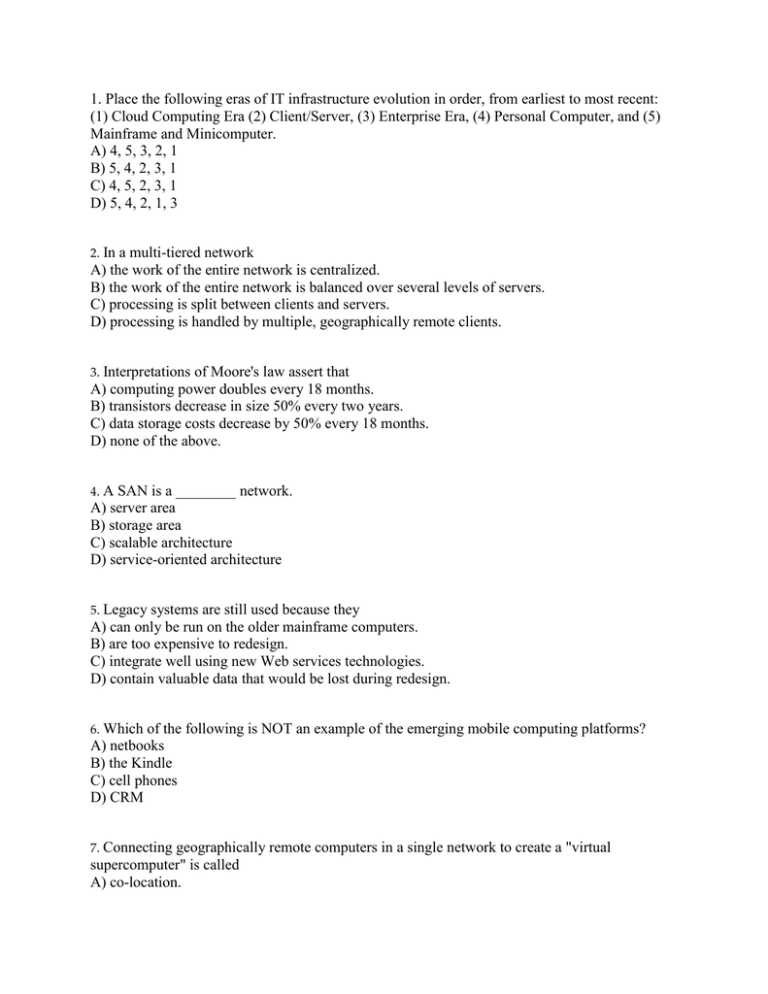
1. Place the following eras of IT infrastructure evolution in order, from earliest to most recent: (1) Cloud Computing Era (2) Client/Server, (3) Enterprise Era, (4) Personal Computer, and (5) Mainframe and Minicomputer. A) 4, 5, 3, 2, 1 B) 5, 4, 2, 3, 1 C) 4, 5, 2, 3, 1 D) 5, 4, 2, 1, 3 2. In a multi-tiered network A) the work of the entire network is centralized. B) the work of the entire network is balanced over several levels of servers. C) processing is split between clients and servers. D) processing is handled by multiple, geographically remote clients. 3. Interpretations of Moore's law assert that A) computing power doubles every 18 months. B) transistors decrease in size 50% every two years. C) data storage costs decrease by 50% every 18 months. D) none of the above. 4. A SAN is a ________ network. A) server area B) storage area C) scalable architecture D) service-oriented architecture 5. Legacy systems are still used because they A) can only be run on the older mainframe computers. B) are too expensive to redesign. C) integrate well using new Web services technologies. D) contain valuable data that would be lost during redesign. 6. Which of the following is NOT an example of the emerging mobile computing platforms? A) netbooks B) the Kindle C) cell phones D) CRM 7. Connecting geographically remote computers supercomputer" is called A) co-location. in a single network to create a "virtual B) edge computing. C) grid computing. D) utility computing. 8. The process of presenting a set of computing resources (such as computing power or data storage) so that they can all be accessed in ways that are not restricted by physical configuration or geographic location is called A) cloud computing. B) autonomic computing. C) virtualization. D) multicore processing. 9. Which type of computing refers to firms purchasing computing power from remote providers and paying only for the computing power they use? A) on-demand B) grid C) edge D) autonomic 10. An example of autonomic computing is A) spyware protection software that runs and updates itself automatically. B) software programmed to run on any hardware platform. C) cell phones taking on the functions of handheld computers. D) programming languages that allow non-programmers to create custom applications. 11. Which type of software is created and updated by a worldwide community of programmers and available for free? A) software packages B) mashups C) outsourced D) open source 12. Which of the following is a technique used to allow users to interact with a Web page without having to wait for the Web server to reload the Web page? A) UDDI B) widgets C) Ajax D) Java 13. Sets of loosely coupled software components that exchange information with each other using standard Web communication standards and languages are referred to as A) Web services. B) EAI software. C) SOA. D) SOAP. 14. What is the foundation technology for Web services? A) XML B) HTML C) SOAP D) UDDI 15. A set of self-contained services that communicate with each other to create a working software application is called A) Web services. B) EAI software. C) SOA. D) SOAP. 16. ________ are created by combining and customizing components from different online software applications. A) Apps B) Mashups C) SaaS D) Web services 17. The practice of contracting custom software development to an outside firm is commonly referred to as A) outsourcing. B) scaling. C) service-oriented architecture. D) application integration. 18. A formal contract between customers and their service providers that outlines the specific responsibilities of the service provider and to the customer is called a(n) A) SOA. B) SLA. C) TCO. D) RFQ. 19. SaaS refers to A) supplying online access over networks to storage devices and storage area network technology. B) managing combinations of applications, networks, systems, storage, and security as well as providing Web site and systems performance monitoring to subscribers over the Internet. C) hosting and managing access to software applications delivered over the Internet to clients on a subscription basis. D) none of the above. 20. Which of the following refers to the ability of a computer, product, or system to expand to serve a larger number of users without breaking down? A) modality B) scalability C) expandability D) disintermediation 21. Which model can be used to analyze the direct and indirect costs to help firms determine the actual cost of specific technology implementations? A) total cost of ownership B) return on investment C) breakeven point D) cost benefit analysis 22. Duplicate data in multiple data files is called data ________. A) redundancy B) repetition C) independence D) partitions 23. A DBMS makes the A) physical database available for different logical views. B) logical database available for different analytical views. C) physical database available for different analytical views. D) logical database available for different physical views. 24. DBMS for midrange computers include all of the following EXCEPT A) DB2. B) Oracle. C) Microsoft SQL Server. D) Microsoft Access. 25. The type of tables is the A) OODBMS. logical database model that treats data as if they were stored in two-dimensional B) pre-digital DBMS. C) relational DBMS. D) hierarchical DBMS. 26. A field identified in a table as holding the unique identifier of the table's records is called the A) primary key. B) key field. C) primary field. D) unique ID. 27. You are creating a video and animation sharing Web site whose content will be supplied by content, video, and applets stored in a database and you anticipate very high loads on the server. Which of the following DBMSs will most likely serve your needs? A) object-relational DBMS B) relational DBMS C) hierarchical DBMS D) OODBMS 28. An automated or manual file that stores information about data elements and data characteristics such as usage, physical representation, ownership, authorization, and security is the A) data dictionary. B) data definition diagram. C) entity-relationship diagram. D) relationship dictionary. 29. The most prominent data manipulation language today is A) Access. B) DB2. C) SQL. D) Crystal Reports. 30. The process of streamlining data to minimize redundancy and awkward many-to-many relationships is called A) normalization. B) data scrubbing. C) data cleansing. D) data defining. 31. A schematic of the entire database that describes the relationships in a database is called a(n) A) data dictionary. B) intersection relationship diagram. C) entity-relationship diagram. D) data definition diagram. 32. You work for a retail clothing chain whose primary outlets are in shopping malls and are conducting an analysis of your customers and their preferences. You wish to find out if there are any particular activities that your customers engage in, or the types of purchases made in the month before or after purchasing select items from your store. To do this, you will want to use data mining software that is capable of A) identifying associations. B) identifying clusters. C) identifying sequences. D) classification. 33. You work for an national car rental agency and want to determine what characteristics are shared among your most loyal customers. To do this, you will want to use data mining software that is capable of A) identifying associations. B) identifying clusters. C) identifying sequences. D) classification. 34. A data warehouse is composed of A) historical data from legacy systems. B) current data. C) internal and external data sources. D) historic and current internal data. 35. OLAP is a tool for enabling A) users to obtain online answers to ad-hoc questions in a rapid amount of time. B) users to view both logical and physical views of data. C) programmers to quickly diagram data relationships. D) programmers to normalize data. 36. ________ tools are used to analyze large unstructured data sets, such as e-mail, memos, survey responses, etc., to discover patterns and relationships. A) OLAP B) Text mining C) Web mining D) Web content mining 37. Which common database challenge is illustrated by a person receiving multiple copies of an L.L. Bean catalog, each addressed to a slightly different variation of his or her full name? A) data normalization B) data accuracy C) data redundancy D) data inconsistency 38. What are the four layers of the TCP/IP reference model? A) physical, application, transport, and network interface B) physical, application, Internet, and network interface C) application, transport, Internet, and network interface D) application, hardware, Internet, and network interface 39. Which of the following Internet connection types offers the greatest bandwidth? A) T3 B) DSL C) cable D) T1 40. ________ work by using radio waves to communicate with radio antennas placed within adjacent geographic areas. A) Cell phones B) Microwaves C) Satellites D) WANs 41. The total amount of digital information that can be transmitted through any telecommunications medium is measured in A) bps. B) Hertz. C) baud. D) gigaflops. 42. Digital subscriber lines A) operate over existing telephone lines to carry voice, data, and video. B) operate over coaxial lines to deliver Internet access. C) are very-high-speed data lines typically leased from long-distance telephone companies. D) have up to twenty-four 64-Kbps channels. 43. Which protocol is the Internet based on? A) TCP/IP B) FTP C) packet-switching D) HTTP 44. Which of the following is not an advantage of using VOIP? A) VOIP can reduce a firm's communication costs by 20 to 30 percent. B) It allows e-mail and voice mail to be combined into a single directory. C) It enables the creation of two distinct networks for voice and data. D) It allows new phones to be added to a network without rewiring or reconfiguring the network. 45. In the domain name "http://myspace.blogging.com", what are the root, top-level, secondlevel, and third-level domains, respectively? A) "http://", myspace, blogging, com B) "http://", com, blogging, myspace C) ".", com, blogging, myspace D) ".", myspace, blogging, com 46. IPv6 is being developed in order to A) update the packet transmission protocols for higher bandwidth. B) create more IP addresses. C) allow for different levels of service. D) support Internet2. 47. Which of the following distinguishes wikis from blogs? A) Wikis allow users to add content, whereas blogs are created by a single person. B) Blogs are personal publishing tools, while Wikis have business uses. C) Wikis require some knowledge of Web programming, whereas blogs are designed to be created by people without HTML skills of any kind. D) Wikis allow users to modify content created by other users, whereas blogs only allow comments to posted material. 48. ________ integrate(s) disparate channels for voice communications, data communications, instant messaging, e-mail, and electronic conferencing into a single experience. A) Wireless networks B) Intranets C) Virtual private networks D) Unified communications 49. A VPN A) is an encrypted private network configured within a public network. B) is more expensive than a dedicated network. C) provides secure, encrypted communications using Telnet. D) is an Internet-based service for delivering voice communications. 50. Web browser software requests Web pages from the Internet using which protocol? A) URL B) HTTP C) DNS D) HTML 51. The most common Web server today, controlling 54 percent of the market, is A) Microsoft IIS. B) WebSTAR C) Apache HTTP Server. D) Netscape Server. 52. The process of employing techniques to help a Web site achieve a higher ranking with the major search engines is called A) VPN. B) IAB. C) SEM. D) SEO. 53. What technology allows people to have content pulled from Web sites and fed automatically to their computers? A) FTP B) RSS C) HTTP D) Bluetooth 54. Which of the following is not one of the four defining features of Web 2.0? A) interactivity B) real-time user control C) cloud computing D) social participation 55. The 802.11 A) Wi-Fi. B) WiMax. C) Bluetooth. D) RFID. set of standards for wireless LANs is known as 56. The next evolution in wireless communication is A) 3G networks. B) 2.5G networks. C) WiMax. D) RFID. 57. Which of the following would you be most likely to use RFID technology for? A) tracking inventory B) enabling CRM systems C) lowering network costs D) enabling client communication 58. ________ refers to policies, procedures, and technical measures used to prevent unauthorized access, alternation, theft, or physical damage to information systems. A) "Security" B) "Controls" C) "Benchmarking" D) "Algorithms" 59. Sniffing is a security challenge that is most likely to occur in which of the following points of a corporate network? A) client computer B) communications lines C) corporate servers D) internal corporate back-end system 60. Inputting data into a poorly programmed Web form in order to disrupt a company's systems and networks is called A) a Trojan horse. B) an SQL injection attack. C) key logging. D) a DDoS attack. 61. An independent computer program that copies itself from one computer to another over a network is called a A) worm. B) Trojan horse. C) bug. D) pest. 62. A salesperson clicks repeatedly on the online ads of a competitor in order to drive the competitor's advertising costs up. This is an example of A) phishing. B) pharming. C) spoofing. D) click fraud. 63. In 2004, ICQ users were enticed by a sales message from a supposed anti-virus vendor. On the vendor’s site, a small program called Mitglieder was downloaded to the user’s machine. The program enabled outsiders to infiltrate the user’s machine. What type of malware is this an example of? A) Trojan horse B) virus C) worm D) spyware 64. Redirecting a Web link to a different address is a form of A) snooping. B) spoofing. C) sniffing. D) war driving. 65. A keylogger is a type of A) worm. B) Trojan horse. C) virus. D) spyware. 66. Hackers create a botnet by A) infecting Web search bots with malware. B) by using Web search bots to infect other computers. C) by causing other people’s computers to become "zombie" PCs following a master computer. D) by infecting corporate servers with "zombie" Trojan horses that allow undetected access through a back door. 67. Using numerous computers to inundate and overwhelm the network from numerous launch points is called a ________ attack. A) DDoS B) DoS C) SQL injection D) phishing 68. An example of phishing is A) setting up a bogus Wi-Fi hot spot. B) setting up a fake medical Web site that asks users for confidential information. C) pretending to be a utility company's employee in order to garner information from that company about their security system. D) sending bulk e-mail that asks for financial aid under a false pretext. 69. Pharming involves A) redirecting users to a fraudulent Web site even when the user has typed in the correct address in the Web browser. B) pretending to be a legitimate business’s representative in order to garner information about a security system. C) setting up fake Web sites to ask users for confidential information. D) using e-mails for threats or harassment. 70. How do software vendors correct flaws in their software after it has been distributed? A) issue bug fixes B) issue patches C) re-release software D) issue updated versions 71. The Sarbanes-Oxley Act A) requires financial institutions to ensure the security of customer data. B) specifies best practices in information systems security and control. C) imposes responsibility on companies and management to safeguard the accuracy of financial information. D) outlines medical security and privacy rules. 72. Analysis of an information system that rates the likelihood of a security incident occurring and its cost is included in a(n) A) security policy. B) AUP. C) risk assessment. D) business impact analysis. 73. An authentication token is a(n) A) device the size of a credit card that contains access permission data. B) type of smart card. C) gadget that displays passcodes. D) electronic marker attached to a digital authorization file. 74. Currently, the protocols used for secure information transfer over the Internet are A) TCP/IP and SSL. B) S-HTTP and CA. C) HTTP and TCP/IP. D) SSL, TLS, and S-HTTP. 75. ________ use scanning software to look for known problems such as bad passwords, the removal of important files, security attacks in progress, and system administration errors. A) Stateful inspections B) Intrusion detection systems C) Application proxy filtering technologies D) Packet filtering technologies 76. 70) Smaller firms may outsource some or many security functions to A) ISPs. B) MISs. C) MSSPs. D) CAs.
